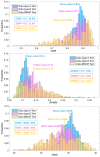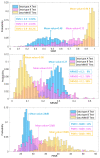Training Universal Deep-Learning Networks for Electromagnetic Medical Imaging Using a Large Database of Randomized Objects
- PMID: 38202870
- PMCID: PMC10780526
- DOI: 10.3390/s24010008
Training Universal Deep-Learning Networks for Electromagnetic Medical Imaging Using a Large Database of Randomized Objects
Abstract
Deep learning has become a powerful tool for solving inverse problems in electromagnetic medical imaging. However, contemporary deep-learning-based approaches are susceptible to inaccuracies stemming from inadequate training datasets, primarily consisting of signals generated from simplified and homogeneous imaging scenarios. This paper introduces a novel methodology to construct an expansive and diverse database encompassing domains featuring randomly shaped structures with electrical properties representative of healthy and abnormal tissues. The core objective of this database is to enable the training of universal deep-learning techniques for permittivity profile reconstruction in complex electromagnetic medical imaging domains. The constructed database contains 25,000 unique objects created by superimposing from 6 to 24 randomly sized ellipses and polygons with varying electrical attributes. Introducing randomness in the database enhances training, allowing the neural network to achieve universality while reducing the risk of overfitting. The representative signals in the database are generated using an array of antennas that irradiate the imaging domain and capture scattered signals. A custom-designed U-net is trained by using those signals to generate the permittivity profile of the defined imaging domain. To assess the database and confirm the universality of the trained network, three distinct testing datasets with diverse objects are imaged using the designed U-net. Quantitative assessments of the generated images show promising results, with structural similarity scores consistently exceeding 0.84, normalized root mean square errors remaining below 14%, and peak signal-to-noise ratios exceeding 33 dB. These results demonstrate the practicality of the constructed database for training deep learning networks that have generalization capabilities in solving inverse problems in medical imaging without the need for additional physical assistant algorithms.
Keywords: antenna sensing; database; deep learning; electromagnetic imaging.
Conflict of interest statement
The authors declare no conflict of interest.
Figures










References
-
- Guo L., Abbosh A.M. Optimization-based confocal microwave imaging in medical applications. IEEE Trans. Antennas Propag. 2015;63:3531–3539. doi: 10.1109/TAP.2015.2434394. - DOI
-
- Baranoski E.J. Through-wall imaging: Historical perspective and future directions. J. Frankl. Inst. 2008;345:556–569. doi: 10.1016/j.jfranklin.2008.01.005. - DOI
-
- Witten A.J., Molyneux J.E., Nyquist J.E. Ground penetrating radar tomography: Algorithms and case studies. IEEE Trans. Geosci. Remote Sens. 1994;32:461–467. doi: 10.1109/36.295060. - DOI
-
- Chen X. Computational Methods for Electromagnetic Inverse Scattering. Volume 244 Wiley Online Library; Hoboken, NJ, USA: 2018.
-
- Yin T., Wei Z., Chen X. Non-iterative methods based on singular value decomposition for inverse scattering problems. IEEE Trans. Antennas Propag. 2020;68:4764–4773. doi: 10.1109/TAP.2020.2969708. - DOI
MeSH terms
LinkOut - more resources
Full Text Sources
Miscellaneous

